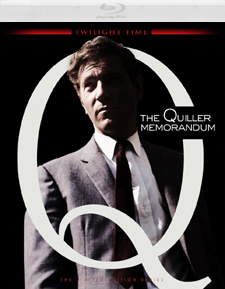Quiller Memorandum, The (Blu-ray Review)

Director
Michael AndersonRelease Date(s)
1966 (March 19, 2019)Studio(s)
The Rank Organization/Ivan Foxwell Productions/20th Century Fox (Twilight Time)- Film/Program Grade: C+
- Video Grade: A-
- Audio Grade: B
- Extras Grade: B
Review
The Quiller Memorandum is based on Adam Hall’s thriller novel about neo-Nazism in contemporary Germany. American agent Quiller (George Segal) arrives in Berlin and meets with his British handler Pol (Alec Guinness). Pol tells Quiller the fascist underground is far more organized and powerful in Germany than people believe. Quiller’s assignment: to discover the location of the neo-Nazi group’s headquarters, a group that has already assassinated two British agents.
Quiller begins by visiting a school where a teacher has hanged himself after accusations of being a war criminal. There, he meets Inge Lindt (Senta Berger), the dead teacher’s replacement, and is attracted to her. He drives her home and is kidnapped by Nazis, drugged, and brought to the leader of the group, Oktober (Max von Sydow), who demands to know the location of British spy headquarters in Berlin.
The balance of the film is a cat-and-mouse game between Quiller and the Nazis taking turns having the upper hand, trying different methods to achieve their goals, and sideswiping confrontations and danger.
Spy thrillers depend on action and plot twists, and The Quiller Memorandum is lax at both. The skeletal plot hardly makes sense and the execution is devoid of excitement.
Segal is a poor fit for Quiller. His attempts at witty bon mots and glibness fall flat, and he lacks charisma. He isn’t helped by the Harold Pinter screenplay, which plods along with little action to pep up the proceedings. The portrayal of secret agenting, meant to be less flamboyant and more cerebral than in the Bond films, unfortunately doesn’t grab the viewer. When you have a dull screenplay with a mundane, miscast leading man, the film is bound to suffer. It’s difficult to accept Segal as a seasoned spy.
Released in 1966 in the wake of the success of the James Bond films, The Quiller Memorandum was one of several pictures that attempted to treat the spy game more seriously and cynically. Directed by Michael Anderson (Logan’s Run), the film features an appropriately villainous performance by von Sydow and fine supporting performances by Guinness and George Sanders, through they are both on screen for far too short a time.
The Unrated Region-Free Blu-ray, featuring 1080p high resolution, is a part of Twilight Time's Limited Edition line of 3,000 units. Aspect ratio is 2.35:1 and the running time is 105 minutes.. The color by Deluxe is quite vivid, evidenced by the bold red lettering in the title credits, von Sydow’s piercing blue eyes, and Senta Berger’s smooth complexion. Backlighting in outdoor night scenes provides a halo effect that makes the actors stand out from the dark background. Most of the daytime outdoor scenes in Berlin are overcast, giving a grayish hue to the images. The headquarters of the neo-Nazi organization is filled with deep shadows and a dark staircase, foreshadowing danger. Details are sharp, but not as pristine as in more recent films.
The English soundtrack is 1.0 DTS-High Definition Master Audio. Optional English subtitles are also available. A gunshot that occurs unexpectedly on a dark Berlin street is dramatically loud, and footsteps are “sweetened” by foley artists to create suspense as Quiller and the bad guys tail one another. An explosion breaks the silence of a tense, otherwise quiet scene, leading to the film’s denouement. Dialogue is distinct throughout, but its pacing is awkward, with overly long pauses. This gives the impression that the actors aren’t focused, though Anderson’s direction is at least partially responsible.
Bonus materials on this single-disc Blu-ray release include John Barry’s isolated score track, an audio commentary, the theatrical trailer, a scroll-through of the Twilight Time catalogue, and an insert booklet.
Audio Commentary – Film historians Eddy Friedfeld and Lee Pfeiffer provide a detailed overview of the Cold War era. They discuss the battle between capitalism and communism, Stalin’s uneasy alliance with the West to defeat Hitler, the division of post-Word War II Germany into “spheres of influence,” and the growing Red Scare in America that led to McCarthyism. The 1960s was a time of widespread distrust of authority. The movie is about “shades of grey.” There are no obvious bad guys. Writer Harold Pinter made a point of keeping characters mysterious. The 1960s saw the emergence of the spy movie as a genre in and of itself. Other Cold War era spy films are mentioned, including The Manchurian Candidate, The Kremlin Letter, and Alfred Hitchcock’s Torn Curtain. When action is used sparingly, they note, it has far more impact. The ending is understated, with characters’ body language communicating what is unspoken. The final question raised: Was the mission successful?
Twilight Time Catalogue – Blu-ray releases by year from 2011 to 2019 are listed with accompanying cover art.
Booklet – The 8-page insert booklet contains a critical essay by Julie Kirgo, photos of scenes from the film, and a color reproduction of the film’s poster.
– Dennis Seuling

